This paper is available in Français too
Like many artists before him, Julien Clerc (a famous French singer) has succumbed to a symphonic sound and has enlisted a group of 40 musicians, with which his songs present and past take on a special importance. Faithful to the artist and assisted by Laurent Midas at the monitor desk, Laurent “Bellote” Delenclos was given the responsibility of the sound on this tour – which is more pop than classical – and has some tricks up his sleeve.

He met us at the Mériadeck ice rink in Bordeaux, (town in the south west of France, word famous for it’s wine) a venue with a very carnival-like sound and where the sound waves bounce around like hockey pucks despite a complete acoustic treatment. This little cha-cha…lle-lle…nge-nge is complicated by the freezing mid-February French temperatures, which bite even more inside the venue!
It is in this tough place that we find Bellote early in the morning while he is checking the installation of heavy black cloth over of the high plexiglass panels that protect the public from the pucks at the back of the hall where the goals are, but also where the front-of-house has been set up on a modular floor laid on the ice, right in the firing axis of the V-DOSC.
Bellote : and you get here just now ? We were waiting for you to give us a hand ! (laughs)
SLU : How long have you been mixing for Julien ?
Bellote : Since 2006. I will also work with him at the Victoires de la Musique Award this year where I will be working anyway. The last tour was pretty minimal and I covered all positions myself. This year, however, Laurent is taking care of the monitors andI am assisted at the front of house by Wilfried Mautret.
The new rules of the game, simplified by Vista

SLU : Could you give us the details of this symphonic ensemble?
Bellote : To keep a rhythmic foundation, there is a drummer without a hi-hat and no tom-toms other than a floor tom. He covers the percussion together with the timpanist and sends just a few sequences. Bass is provided by contrabasses and cellos. In fact the arrangements were written by Philip Uminski, who has no classical training, therefore the result was, say, classical-pop in which the classical musicians have had to find their bearings. For example, the basses have to play the staccato notes with the bow, something that initially did not thrill them at all!

SLU : I imagine that changes quite a bit the approach with DI-boxes and…
Bellote : …seven musicians for the low string section: three basses and four cellos! It does change! The basses provide the infrabass and the cellos provide the attack. The sound is also somewhat unusual as each bass provides a signal from a microphone and from a Schertler transducer. This relative luxury requires a mixer with a high capacity in terms of inputs, the Studer Vista 5SR. I stuck my nose in it and it’s a damned fine console! A great surprise

I can for example have EQ and dynamics on the VCAs. Take, for example, my eight violins called V1. I equalize all eight out of the VCA. It allows me to have forty-six musicians on thirty faders. Out of habit I placed the VCA fader low against the kick-drum and the snare, even if we are talking about a symphonic ensemble (he laughs). With the Studer console you can really can completely configure the console and this is not an exaggeration. This is the first time I am actually using a digital console without fiddling with it, not adding to it whatever it takes to give it a sound, preamps, summers. I just use an external clock and I find the result amazing, really good.
To each his clock? Yes, it’s possible !
SLU : An external clock on a Studer ?
Bellote : Actually, you can really tell the difference. I don’t know what they put in it, but it does work better with a Mutec iClock. It’s loud and clear. The only desk I can use without an external clock is the SSL. Since the Vista is really conceived as a broadcast console, I reference it to black burst. You can do anything, it’s the hacker’s dream and you can go really far with it.
SLU : On LoMid’s (Laurent Midas) racks I think I saw his Antelope Trinity clock for his console reference. How do your two clocks get along ?
Bellote : Normally we should both be locked to the same clock, but in our case MADI somehow accepts this double reference. Just in case, we ran a BNC between the two boards and, as his Trinity is more stable than my Mutec, I had planned to sync mine to it, but 100 meters of coaxial struck me as too long… then well, as it works anyway, we left it as is (he laughs). We were told that this is possible because MADI is very flexible as far as its clock goes, however there is no guarantee that if I switched my Mutec to WordClock it would work as well!
Atypical miking for a symphonic introvert

SLU : Let’s get back to your miking of the strings. You play with proximity.
Bellote: Yes, absolutely. I started by putting Schoeps everywhere and tried overhaed and distant miking, but I quickly calmed down. This symphony is so crammed together that I end up with the drums a metre away from violins, which never happens in “real life”. I love Schoeps but they pick up too generously, so I backed up to more reasonable and manageable choices.
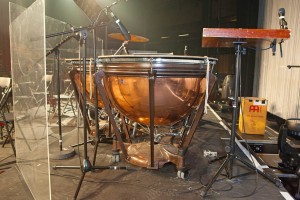

I chose the DPA 4099 that sounds good, is highly directional, stable and has a handy clip. For flutes I chose AKG C535, Audio-Technica ATM350 for clarinets and two for the oboes, one at the mouthpiece and one at the fingers. For horns I used Neumann TLM102s and AKG C414s on the brass. The plexiglass shield behind the horns absorbs some of the bleed from the basses which are right behind them and from which I take more air than string sounds!
SLU : A drumset without a hi-hat: interesting…
Bellote : It does not really fit, however there is a nice trick with a foot pedal and a tambourine to punctuate certain songs. For the bass drum and floor tom I placed a Beta 52 that I deal with very softly. The snare for example is picked up only by a C414 above. It is not rock’n’roll. On the timpani I have Sennheiser 421s and a Shure SM137 for small percussion.
SLU : And for the voice of Julien?
Bellote : A Sennheiser 5000 with a classic dynamic head, the 5500,which is no longer on the market, and that’s a real shame. I like that much better than the Neumann head that fits on the same transmitter, that is to say I like it better than the way that the HF compander on the transmitter reacts to condenser heads with a response as wide as the Neumann’s. I love the wired Neumann, but not the wireless version. I unfortunately failed to convince Julien to sing with a wired microphone, at least this time! He told me he likes to be able to walk in the orchestra.

SLU : I see two pianos : that’s not very symphonic either…
Bellote : That is normal! Julien plays his own and Alain Lanty, his old friend, plays on the other, which is in fact a fake piano that allows him to vary the accompaniments. Sometimes he switches to Julian’s when the latter stands to sing facing the audience. To get signal from the main piano and have several options, I work in three ways. First I have a couple of Schoeps CMC6 mounted on MK4 placed underneath, as he plays with the lid closed. These two microphones, as does the piano as a whole, stand on rubber isolators (silentblocs). Then I have a pair of Yamahiko pickups, which are accelerometers that are placed between the soundboard and the structure to strengthen the bass a little, that go into DI boxes. It’s a Yamaha Silent Piano which we use acousticly because I find the sound nicer, but sometimes I have to switch to the electronic output during the concert because it cannot keep the tuning. It gets shaken a lot and especially exposed to excessive temperature variations. We could rent a piano in each city, but we’ve had some surprises in the past, so we’d rather carry around our own.
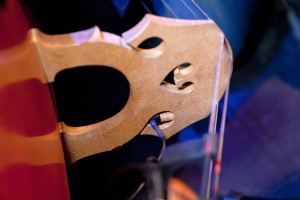
SLU : How do you and Laurent share the mics ?
Bellote : We chose to be on the same Studer preamps, mine, therefore Lawrence’s Vi6 is fed by the redundant output of my stagebox. Microphones are connected only to one set of electronics: a guarantee of quality. As I’m wired to output 1, my console controls the input gains.
SLU : But this creates a bit of the latency and the boss does not like that… (On a previous tour, Bellote had invented a zero latency output not to bother Julien’s ear monitors – Ed.)
Bellote : That’s right, but back then it was a Digidesign that reaches 3 milliseconds and thus creates a comb filter stack where it should not be between head voice and monitor voice. The latency of the Studer is less than 2 milliseconds, which pushes the comb to higher and less noticable frequencies. He is delighted because he also has the lastest EARSONICS EM6. Laurent will tell you better, but they are the first ear monitors that he doesn’t have to equalize!!!
Two nice reverbs and a Multirack Waves

SLU : Still using very few effects, I see…
Bellote : Two very beautiful reverbs still: a LEXICON 960 and a TC 6000. The 960 is on the strings and woodwinds to restore depth and length to a very close miking that cancels the “orchestra” consonance too much. The 6000 is for Julien’s voice. I provide him with depth by giving him small delays and reverb. I also have a MultiRack WAVES in the MAC that I use to treat Julien’s voice with a C6 multiband compressor and a CLA76 monoband compressor/limiter. I also have a LoAir plug I use to beef up the end of certain songs or short, low passages. It also seems that Multirack will soon be open to other plugin brands, which is going to be a nice touch, because not only Waves knows how to develop them!
SLU : As far as sound goes, are you satisfied with the plug-ins in general ?
Bellote : Ahh yes, I am, and above all it is so convenient … I don’t carry around any outboard anymore and with this setup and my MADI card I can do 64 inserts!
SLU : Don’t you like Studer compressors ?
Bellote : They are not bad but … The basic model is too simple, I tried the “Vintage Dynamics” which is more customizable and it does the job without being over the top. At the risk of simulating an analog effect, I chose an external algorithm on WAVES. The equalizer, however, is very effective and so are low and high peaks, which slopes you can adjust at -12, -18 or -24, that’s terrific! (A leopard cannot change its spots – Ed.). Another highlight in this console is the VIRTUAL SOUND PANNING with which in classical music I can open up my orchestra without penalizing spectators on the sides. This is the ideal classical console and this function is just great. So I put it everywhere. (He laughs!)
SLU : And your mono sends?
Bellote : I don’t have any, I took out one side. Honestly this phases a bit, it works with delays. The true mono sum is a little weird but since I did not pan anything, my two sides can do the trick! On the console stereo, outputs and groups both, you have huge stereo expanders. Vitalizers in comparison are nothing. At 200% it’s unbelievable, it turns you upside down. I use it at one point in the show when Alain Lanty makes some liner/accompanying notes and it sounds really good. I use only 20% of the console automation, but I’m thrilled with it.
SLU : Had you ever practiced with Vista ?
Bellote : No! I spent three weeks alone with my nose stuck in the manual to understand it and make my list of questions. I would have done better to get help from someone who knew it well because it’s really felxible. You can configure, everything including the number of channels on a fiber using dip-switches inside the box. Needless to say, if the previous user has put his hands in it, you can spend a while before you figure out how, especially when you’re not used to this model, whose power is definitely remarkable. Finally, you can mix three hundred inputs to three hundred outputs through the MADI.
SLU : A few words about the routing…
Bellote : I have three MADI cards. I use one with the Mac to do my 64 inserts with the Waves Virtual Rack via an RME card. I use the second one to record the show and to do the virtual soundcheck with Logic – I have two fiber runs and 128 channels for it on an SSL card – and the last one to receive signals from the stagerack on the stage. I also send all my 128 signals to Laurent so he, in turn, can record on his Logic and also do a virtual sound check. As I do not have fiber patch, I mix by hand. I lose in convenience what I gain in reliability by removing a layer of electronics that may still fail.
SLU : What are the tiny Meyer enclosures around your console ?
Bellote : They are MM-4XP. They are tiny but appearances deceive. They are powered by their MM10 sub and I measured them (really it is the first time… – Ed.) they are definitely right. There’s really nothing to say. Listen. You get a lot of bang for such a tiny size. They are as pre-emphasized as Bose but they sound better. I route the talkbacks and the PFLs into them. They are designed for installation but I thought they were just fine for traveling light. (I confirm, they sound good, clear, dry and strong, very Meyer, with of course a very pronounced directivity – Ed.)
SLU : Your Mac does a lot of tricks…
Bellote : And it is far from being overloaded. This is my all-purpose tool. It plays the background music, runs the Flux analyzer, Logic with 128 tracks and the Waves Multirack. It is a quad-core and even when everything is running, we still get 60 fps.
Sound by Bellotte
SLU : Tell us about your sound
Bellote : I opted again for complete FIR filtering that I created using four Dolbys, two for the left and two for the right connected together in Dante. The signal goes into the first processor in AES which takes care of the signal distribution in Dante via a 1GB router. I also have four spare analog output pairs in case I lose the network or AES. The only problem is that I have to correct the small latency due to the Dante protocol in the three Dolbys that receive it from the first, which generates it. In these I put small delays to keep the speakers in phase. It is also the first machine that converts the 48 kHz of the console to 96 kHz, so that the four Dolbys are perfectly synchronized
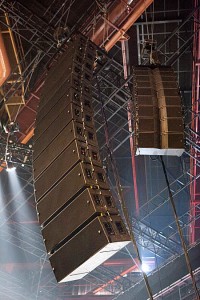
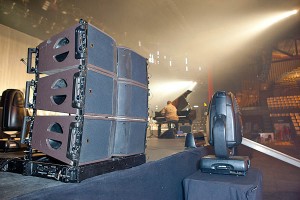
SLU : And the sound system ?
Bellote : Twelve V-DOSC per side for the front and twelve KARA each for the sides – nine flown and three stacked – and a single, central cluster of twelve SB28 subs. This is my basic kit. The two sets of three stacked KARA are used to bring the image downward. I also have four Meyer UPJs, and I exploit their ability to rotate the driver 90 degrees. They are 80°x40° and I lay them on their sides. Since Meyer knows how to control phase and L-Acoustics does as well, the speakers are a perfect match.

SLU : Tell us about your mounting the subs in a central array. Where does that come from ?
Bellote : It’s a dream. Having only one point of emission for the infrabass is already ideal and you cannot do that very often. Then I was faced with the difficulty of having to manage an orchestra with sixty microphones on stage and the desire not to sound “Mickey” (he laughs). I don’t give up on a real bass and on a correct level because it’s classical. So I decided to clean up the stage behind the subs as much as I could. A cardioid mode is not bad, but at 30 Hz it doesn’t work. So I decided to create an array consisting of four groups of three subs that could maintain the directivity down to 30 Hz The choice of stacks with 3 units each is dictated by the desire to not have too much directivity at once reflecting from the back of the room. Each group is separated from the other by four feet not to exceed half the wavelength. With these twelve subs I only cover between 30 and 60 Hz. The V-DOSCs extend down to 60 Hz and I add one more octave to them. Tonight my array is a little too forward but I could not do otherwise. As the lobe I generate extends from halfway through the group, I could have put it underneath Julien, which would better cover the front rows. The other advantage of this configuration is that I have fewer reflections from back of the room, the bass is more distributed, more homogeneous.
SLU : Have you delayed your subs to help the sound “falling” more on the audience ?
Bellote : No, no need to. They only go up to 60 Hz and, as I have stacked three boxes vertically, it does not pose a problem. However, when you start to put in 8 or 10 of them, they should be delayed. At Bercy (for Mylène Farmer – Ed.) I used 16 subs, and it was so directive that it was absolutely necessary to delay them. With my twelve SB28s I get useful headroom, just enough for an artist even as “quiet” as Julien. I also prefer to have my subs elevated to avoid blowing away an audience that is not used to such thrills. When you you’ve paid € 60 to listen to a singer and you find yourself in the front you could be very unhappy. Let’s not forget that it is very unpleasant to deal with such a puree, even if it’s rock. Vlad had the same array for Farmer, I think, but on the ground. The only thing new here is having it flown. (Not quite, Vladimir Coulibre’s arrays had four groups of four SBs, the lower element of which was turned 180° – Ed. ).

SLU : And how do you crossover between the V-DOSCs and the SBs?
Bellote : A Linkwitz-Riley 24 dB/8va at 60 Hz on Doscs. It is useless to push them down more, they would create interference and deprive me of the advantage of having only one central point of Subs. I would start to create lobes again, which is something that can just be avoided with this arrangement, and then V-DOSC is not designed to go down so low. K1 definitely is, but not V-DOSC.

SLU : Is it easy to fly your twelve subs ?
Bellote : Very, they remain in the cases in threes. The riggers and I mounted a prerigged 500 mm truss. We arrive with our four sets, pull them up and it’s over. In those few rare venues where we cannot find a place or where we are blocked by the total weight, 1400 kg, we do a left right. For the V-DOSCs and KARAs, I go through a classic simulation with SoundVision and then we refine the room. Here, for example, we will lower the gain on the three elements at the bottom of the arrays because the highs would be too piercing. We cannot send the same level of highs to an entire array that has its top elements pointing out above the audience where the heat and the distance will attenuate them and the bottom ones ten meters from the ears of the first people in the audience. We therefore measure only in relation with the three bottom elements and align them with the overall response measured from the front-of-house. I will also attenuate the highs of the KARAs.
Conclusion
The room gets dark and when the orchestra starts playing the first notes, removing the many foul impressions collected during the short soundcheck where the artist sang with his foot on the brake and there was an empty room with its plastic seats to see and hear. Bellote’s mix goes perfectly with an orchestration that sounds very pop, a mix where conventional instruments are well reproduced despite the proximity with which they are miked. Only the voice seems too up-front to me, an impression that fades quickly, as Julien starts singing less powerfully and Laurent avoids it thorough compensation at the console. The way the voice sounds is very natural and dynamic, and intelligibility is good. The choice of microphone is suited to the artist. The orchestra performs well even if, had the reverb between been a tad longer on the 960, the instruments would have sounded more welded together, providing a more symphonic overall touch. As I already noticed at Zazie’s concert at the Olympia with Yves Jaget as sound engineer and Laurent working the system, the V-DOSC filtered with FIR breaths much better, has an even sharper high end and loses much of its “native” default in the midbass. Horizontal coordinates have also been modified, and without comparing it to newer systems in terms of its spatial positioning, V-DOSC still does a damn good job, with a color like no other in the top end and a performance that adapts perfectly to classical and vocals. What should I say of the array of subs? It works and its performance is so surgical in terms of directivity that it would appeal to American soldiers. We cruised with Bellote in the “array of death”, and simulations proved that that famous last octave is controlled at nearly meter and a half, leaving the stage quite clean and the low-pass filters more peaceful than usual. A walk in the room shows the wisdom of that choice with just one regret: the lack of impact of the nine KARAs at the bottom, once outside of the coverage of the V-DOSCs. Even if the lobe generated by the twelve SB28s fills the room well, you perceive a gap between the quite unique lows of the two 15″ in FULL and the thinner ones spit out by the two 8″ Karas. The basses are both full and precise near the orchestra and in the axis of V-DOSCs and stay that way even in the depths of the balcony, but they decrease gradually as you move laterally and away from the V-DOSCs and from the set of subs that, remember, do not go above 60 Hz.
But this is nothing if compared to the real problem of this room: its big, ugly reflections. The audience sitting between halfway up the auditorium and the stage receive thick reflections from behind their ears. This happens even near the balcony, at the sides and near the stage: the ratio between direct and reflected sound flies very low, because of dense back and side-tracking that the Karas tuned at -9 dB manage to cover up only weakly. We applaud Bellote’s choice of avoiding the policy of carpet bombing that generates as many problems as it solves, and would not have stuck with the nature of the show and its audience. The level remained reasonable, in favor of dynamics that let the show breathe, even if this means that, in some places, the sound was less pristine. Laurent can keep telling me that the venue in Chambery, as brand new and well-rounded as it is, is still more reflective than Mériadeck, I think it is time that only ice skates should resonate in this place and that music be finally welcomed in a music hall worthy of that name. Unfortunately the ambitious Grand Arena* to be built in Floirac lost its funding in early 2012, and despite the courage of local elected officials, it seems that the ice rink will still have some good times ahead. It seems that it will be at least 3 years because, in this day and age, the pockets of bankers are full of sea urchins.
SIM plots
 Here is a SIM representation of the array as deployed by Bellote at 32 Hz. The behavior is as described and, especially, felt in the room with a strong rear rejection, even at such a low frequency.
Here is a SIM representation of the array as deployed by Bellote at 32 Hz. The behavior is as described and, especially, felt in the room with a strong rear rejection, even at such a low frequency.
 At 50 Hz a slight back lobe forms, and it’s inevitable, given the choice not to take it too far ahead. That lobe, in practice, causes very little inconvenience since the subs cover only one octave and are cut starting at 60 Hz.
At 50 Hz a slight back lobe forms, and it’s inevitable, given the choice not to take it too far ahead. That lobe, in practice, causes very little inconvenience since the subs cover only one octave and are cut starting at 60 Hz.
 At 85 Hz the simulation shows a rear lobe opening like a flower, but is still weak if compared to the energy thrown forward and to the larger cleanliness obtained in the back.
At 85 Hz the simulation shows a rear lobe opening like a flower, but is still weak if compared to the energy thrown forward and to the larger cleanliness obtained in the back.
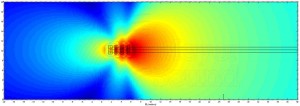 Just for fun, the same array at 125 Hz, a very high frequency where generally the SB28 does not venture.
Just for fun, the same array at 125 Hz, a very high frequency where generally the SB28 does not venture.







